Coursera’s 2020: Year in Review
Propelled by the pandemic, Coursera’s user base increased by 66% in 2020.
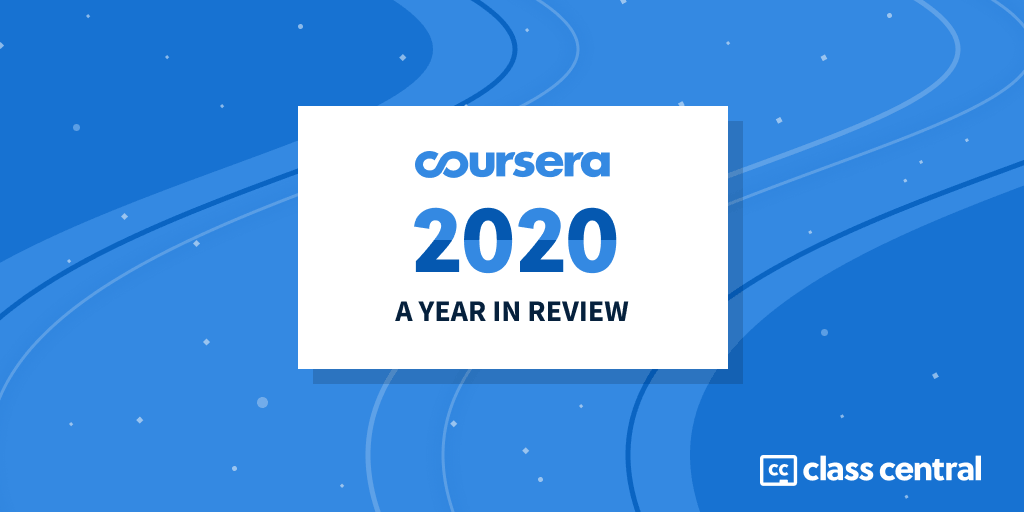
Coursera’s pandemic response and strong course catalog boosted its total number of learners from 45 million last year to 76 million this year.
The pandemic response also helped them make inroads into two business lines: Coursera for Campus and Coursera for Government.
Coursera attracted as many learners in 2020 alone as its closest competitor did in its entire existence. Among others, the company doubled its valuation, opened its platform to hundreds of professional creators, and launched a new catalog subscription and experimented with another one.
All this has set up Coursera for a potential 2021 IPO.
For Class Central‘s complete analysis of Coursera’s 2020, keep reading. For our previous years’ analyses, follow the links:
- Coursera’s 2019: Year in Review
- Coursera’s 2018: Year in Review
- Coursera’s 2017: Year in Review
- Coursera’s 2016: Year in Review
By The Numbers
| 2016 | 2017 | 2018 | 2019 | 2020 | |
| Employees | NA | NA | 330+ | 450+ | 760+ |
| Revenue | $60M | $100M | $140M | NA | > $200M |
| Courses | 1,700 | 2,700 | 3,100 | 3,800 | 5,540* |
| Specializations | 160 | 240 | 310 | 400 | 570** |
| Degrees | 2 | 4 | 12 | 16 | 25 |
| Learners | 23M | 30M | 37M | 45M | 76M |
| Coursera for Business customers | 30 | 500 | 1,500 | 2,000 | 2,300+ |
*4600 courses with 940 Guided Projects from Coursera Project Network
** Count includes Specializations that have been translated. Unique Specializations are around 500.
Courses
Coursera’s total number of active courses has jumped from 3,800 to 5,540. But 940 of these are “Guided Projects” launched by Coursera Project Network. More about these project-based courses further below.
Here are the ten most popular courses launched by Coursera in 2020.
- COVID-19 Contact Tracing from Johns Hopkins University ★★★★★(8)
- Crash Course on Python from Google
- Science Matters: Let’s Talk About COVID-19 from Imperial College London ★★★★★(7)
- Mind Control: Managing Your Mental Health During COVID-19 from University of Toronto ★★★★★(6)
- Fighting COVID-19 with Epidemiology: A Johns Hopkins Teach-Out from Johns Hopkins University ★★★★★(4)
- Excel/VBA for Creative Problem Solving, Part 1 from University of Colorado Boulder
- Finding Purpose and Meaning In Life: Living for What Matters Most from University of Michigan ★★★★★(2)
- Introduction to Git and GitHub from Google
- COVID-19: What You Need to Know (CME Eligible) from Osmosis University ★★★★★(10)
- Everyday Excel, Part 1 from University of Colorado Boulder
Class Central’s Report has compiled a list of the 100 most popular courses launched in 2020.
Specializations, MasterTracks, and Professional Certificates
| Type | 2018 | 2019 | 2020 |
| Specialization | 310 | 400 | 570 |
| Professional Certificate | 0 | 13 | 26 |
| MasterTrack | 3 | 6 | 18 |
Online Degrees
In 2020, Coursera announced nine master’s degrees from six universities. Four are offered by Russia’s Higher School of Economics (HSE). These were just announced last week and should receive their first cohort in September 2021.
At their annual partners conference, Coursera shared some degree enrollment numbers:
- 300+ students enrolled in CU Boulder’s electrical engineering online master’s.
- 2000+ students enrolled in the University of London’s computer science online bachelor’s.
| Degree Name | University | Cost |
| [+] Master of Science in Management | University of Illinois | $10,872 |
| [+] Bachelor of Applied Arts and Sciences | University of North Texas | ~$40k* |
| [+] Maestría en Inteligencia Analítica de Datos | Universidad de los Andes | NA |
| [+] Master of Science in Data Science | University of Colorado Boulder | NA |
| [+] Master of Science in Population and Health Sciences | University of Michigan | $40320 or $44,520* |
| [+] Master of Business Analytics | HSE University | 1,280,000 RUB |
| [+] Master of Computer Vision | HSE University | 1,320,000 RUB |
| [+] Master of Data and Network Analytics | HSE University | 1,200,000 RUB |
| [+] Master of Finance | HSE University | 1,280,000 RUB |
| Master of Machine Learning and Data Science | Imperial | £28,000 |
| Maestría en Ingeniería de Software | Universidad de los Andes | $9,800 |
| Master of Data Science | Natural Research University Higher School of Economics | 675,000 – 1,350,000 RUB |
| Master of Science in Electrical Engineering | University of Colorado Boulder | $20,000 |
| Master of Computer and Information Technology | University of Pennsylvania | $26,300* |
| Global MBA | Macquarie University | AUD $33,000 |
| Bachelor of Computer Science | University of London | £10,592 – £15,889* |
| Master of Computer Science | Arizona University | $15,000 |
| Master of Computer Science | University of Illinois | $21,440 |
| Global Master of Public Health (GMPH) | Imperial College London | £12,000 or £20,100* |
| Master of Public Health | University of Michigan | $40320 or $44,520* |
| Master of Applied Data Science | University of Michigan | $31,688-$42,262 |
| Master of Business Administration (iMBA) | University of Illinois | $21,744 |
| Master of Computer Science (Featuring Data Science Track) | University of Illinois | $21,440 |
| Master’s of Accounting (iMSA) | University of Illinois | $20,564 – $27,200 |
| MSc Innovation and Entrepreneurship | HEC Paris | 21,950 EUR |
Coursera for Business
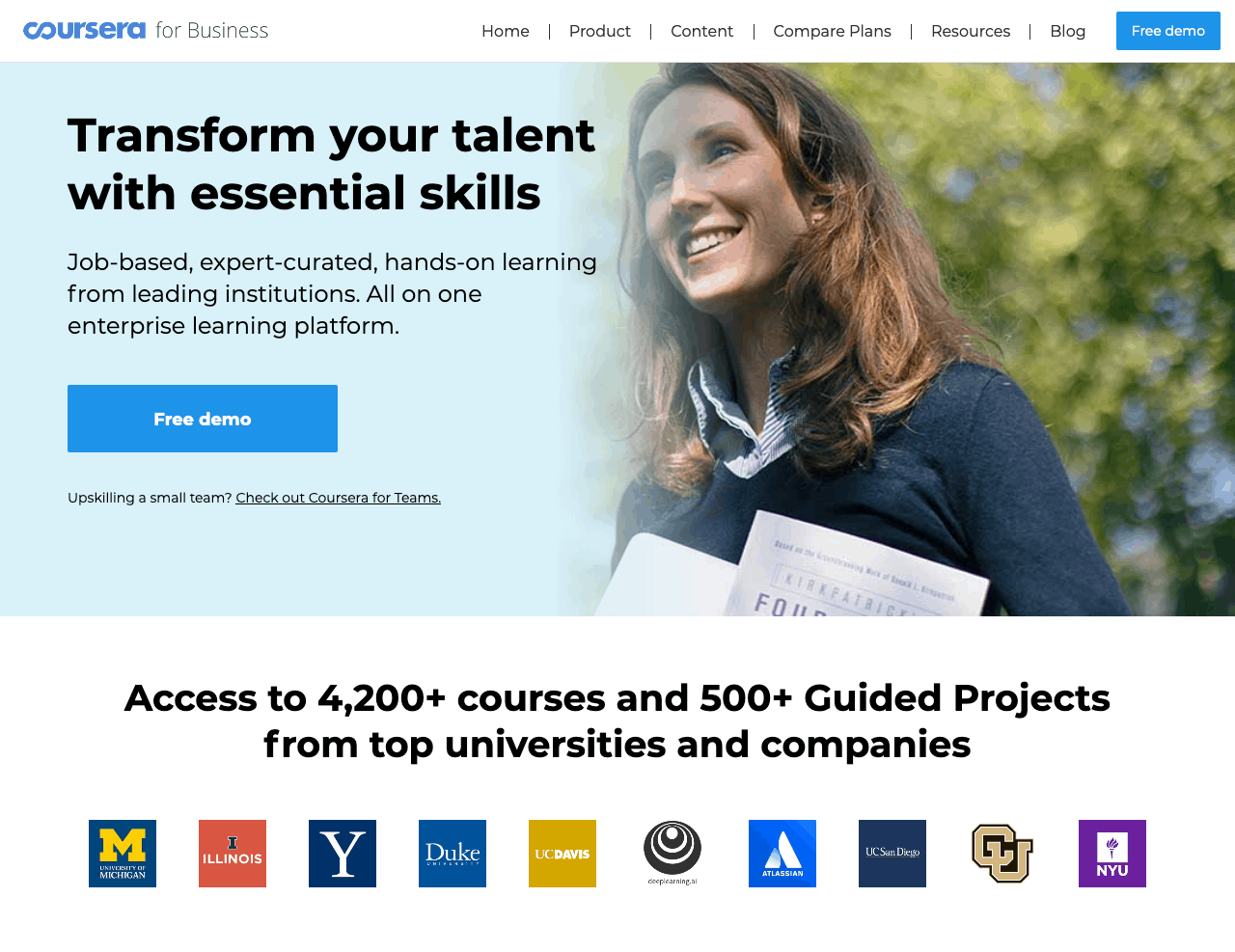
2300 enterprises signed up for Coursera for Business, including 25% of the Fortune 500 companies. According to Coursera’s 2020 Impact Report published in September of this year, the company served 550K enterprise learners.
Pandemic Response & Impact
Coursera’s pandemic response has four key components. If you want to learn how other providers responded to the pandemic, Class Central has got you covered.
Free Certificate Courses
In late March, the company announced they’d be making 85 of their certificate courses free till the end of May. The offer duration and its course list were extended twice.
In total, Coursera made 115 certificate courses free till the end of 2020. The offer proved immensely popular. It became Class Central’s Report most popular article ever, with three million pageviews.
Class Central compiled a list of over 100 providers that offered their online content for free during the pandemic.
Free COVID-19 Courses
Coursera launched courses about COVID-19. Many became some of the most popular online courses of 2020. The top one was Johns Hopkins’ COVID-19 Contact Tracing which crossed over a million enrollments, resulting in at least 340K completions.
Here is a comprehensive list of 50+ COVID-19 courses launched by different providers.
Free Coursera for Campus
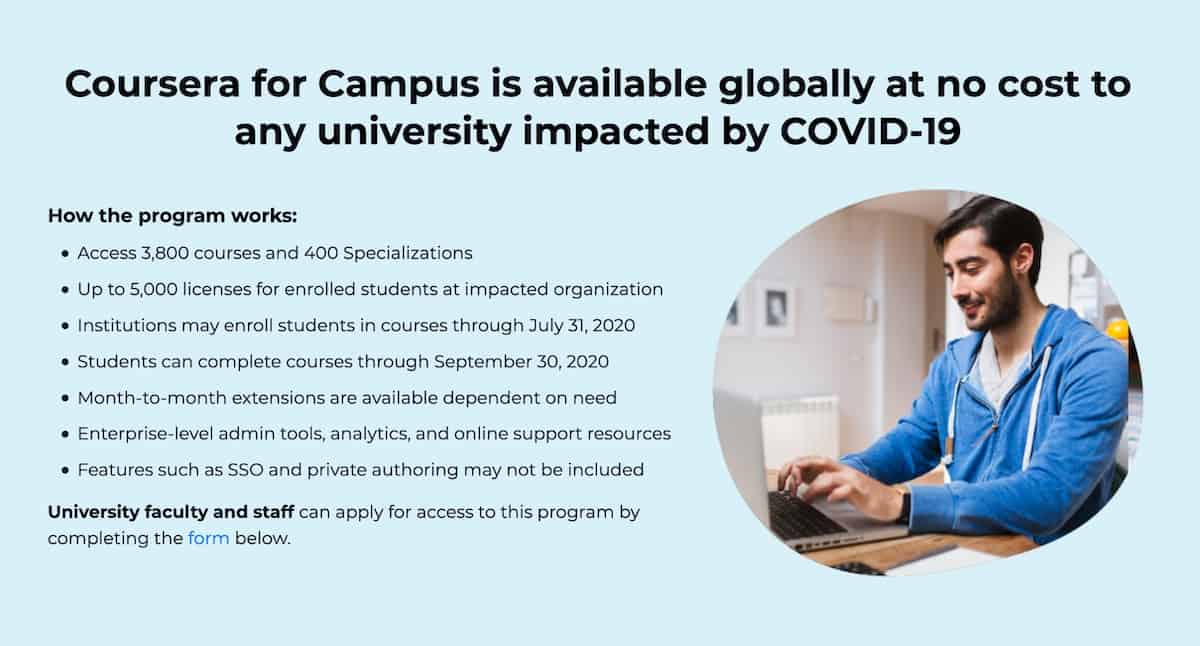
On March 12th, Coursera announced they’d give free catalog access to all higher-ed institutions impacted by the pandemic via Coursera for Campus. Universities can sign up to give 5000 of their students access to Coursera’s catalog of 3800 courses and 400 specializations.
According to Coursera, this offer was taken up by over 10K departments, schools, and universities, benefitting 1.7M learners.
According to Coursera’s 2020 Impact Report, Coursera for Campus is used in 3700 campuses and has 2.4M learners in total.
On June 1st, Coursera announced free catalog access for all university students. Simply put, it’s Coursera for Campus, except universities don’t need to apply to join the program. The caveat is that you need an email address provided by your university, and your university’s domain should be part of Coursera’s database.
This led to 1.2M enrollments.
Free Coursera for Government

On April 24th, Coursera extended a similar offer to governments, this time via its Coursera Workforce Government Recovery initiative. It would allow governments to give unemployed workers access to Coursera’s catalog. Each government would receive up to 50,000 licenses.
This effort attracted 1.1 million learners across 70 countries, resulting in 6.6 million course enrollments.
According to the 2020 Impact Report, Coursera for Government is used by 325 government agencies and 725K learners.
Fundraising, Monetization, and Revenue
According to The New York Times, before the pandemic, Coursera projected its revenue to grow 30% to reach over $200 million. The pandemic pushed it well past that number. You can learn more about Coursera’s monetization journey here.
This helped Coursera raise $130 million in a Series F funding round at a $2.5 billion valuation. Last year, the company raised $103 million, reaching a $1 billion valuation and achieving so-called “unicorn” status.
In total, the company has raised $464 million. According to Coursera, the last funding round brings the company’s cash balance — that is, the amount of money the company has on hand — to $300 million.
Coursera might very well IPO next year.

In 2020, Coursera introduced Coursera Plus, a $400 annual catalog subscription. They started testing the offering in 2019, as first revealed by Class Central’s Report.
A couple of months ago, we reported that Coursera was testing a $59 monthly catalog subscription. Currently, this monthly pricing hasn’t been widely deployed.
Guided Projects via Coursera Project Network

Over the years, Coursera has been very picky regarding university partners. Universities that aren’t ranked highly have not been allowed to offer courses on Coursera.
In 2020, this has changed, to a certain extent.
Last year, Coursera acquired Rhyme, an edtech startup based in Sofia, Bulgaria.
The company’s software allows learners to use their browser to access virtual environments. These environments can be preconfigured to include all the software and tools needed for a project. In addition, they can include embedded video instructions for students to follow along.
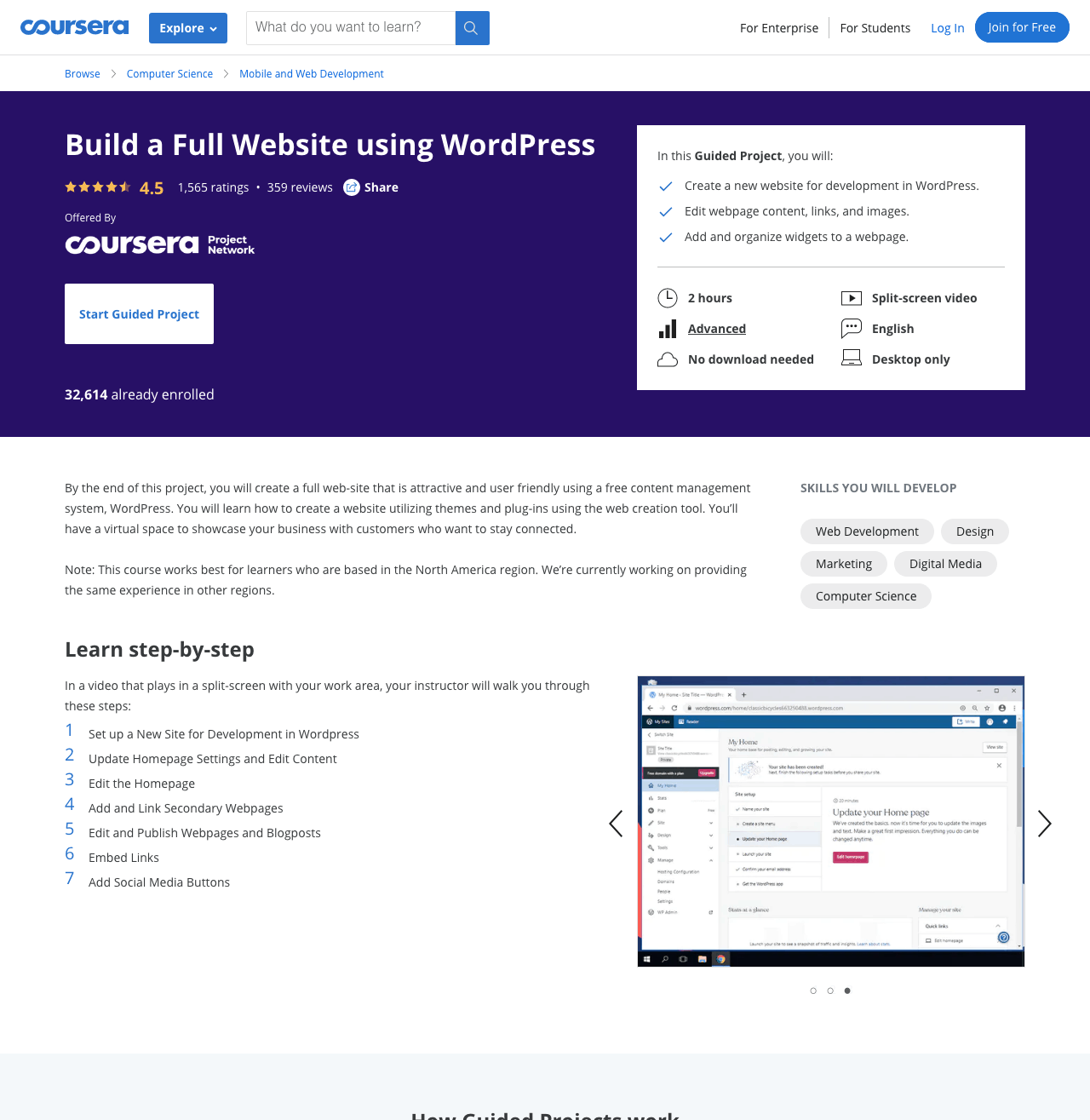
In 2020, Coursera started calling Rhyme courses “Guided Projects” and launching them under the Coursera Project Network.
These project-based courses cost $9.99 and generally take under two hours to complete. In theory, this could be really useful for students, but Coursera’s execution leaves a lot to be desired.
At Class Central, we even stopped listing these courses in our catalog.
To scale the creation of these courses, they started accepting applications from “subject matter experts” around the world at teach.coursera.org.
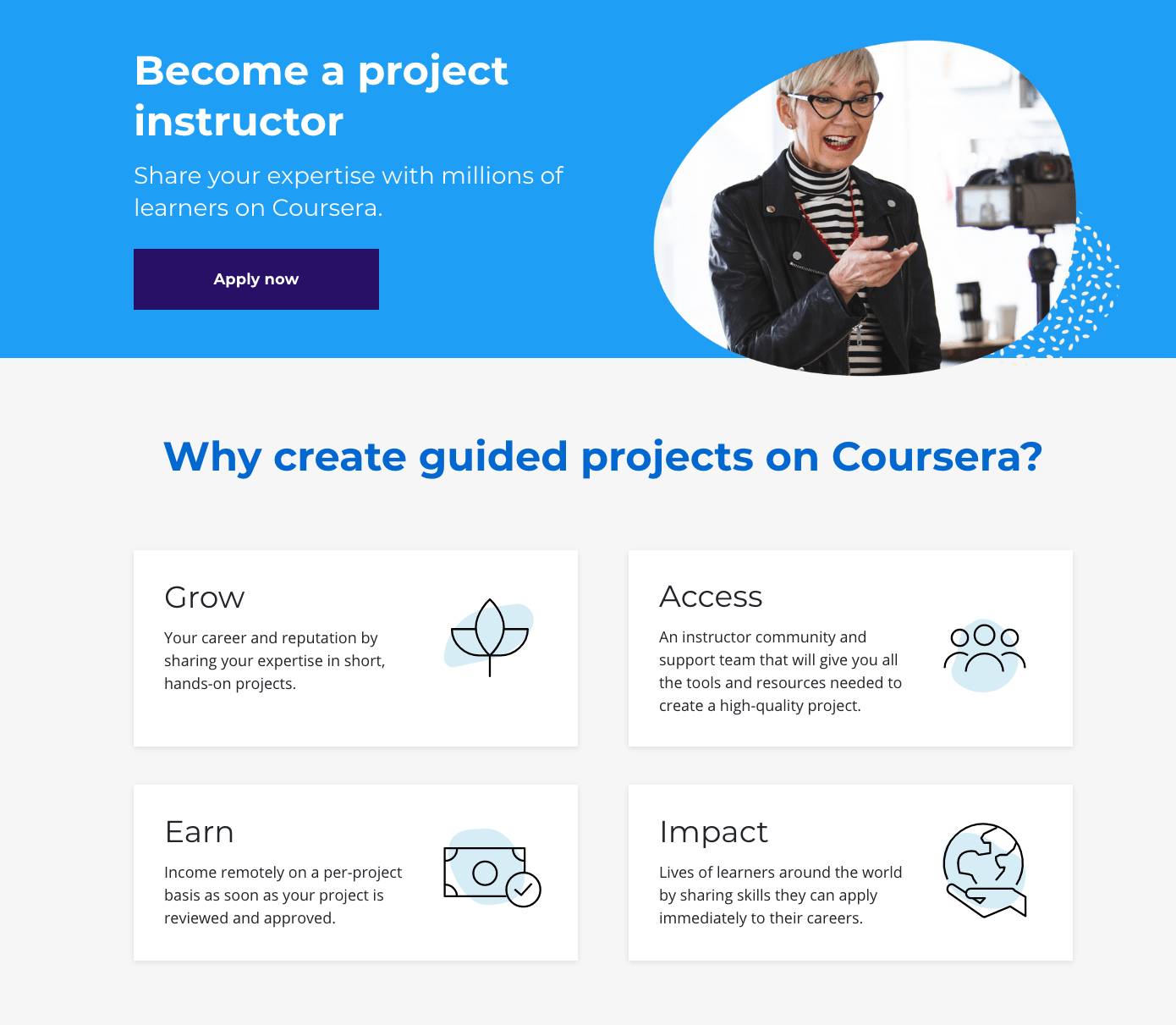
The topics (and potentially quality) seem all over the place. Some feel too small — like they should be part of a broader course. And some feel like they shouldn’t be courses at all…
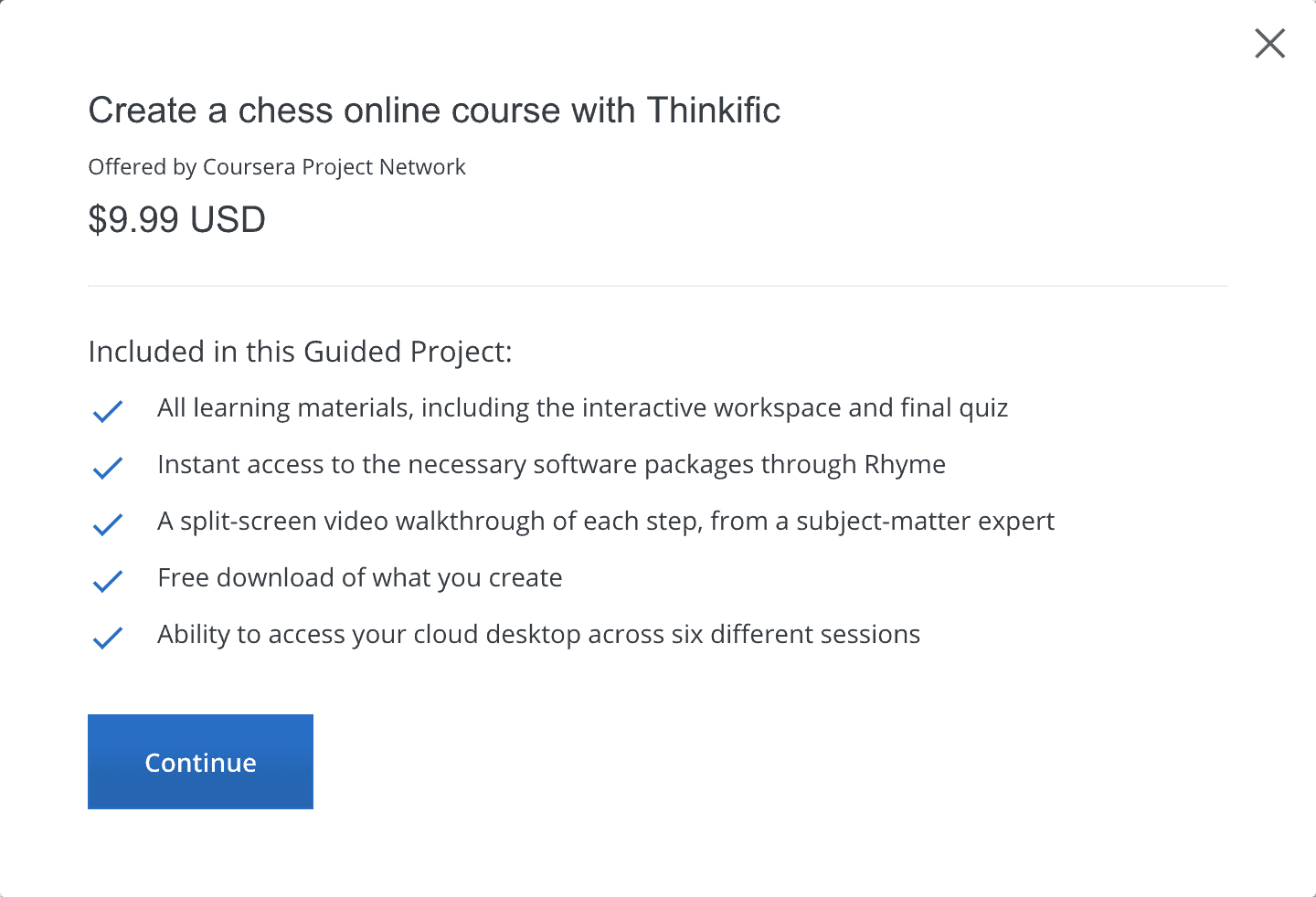
Another drawback is that you can only launch the virtual cloud desktop six times. Also, the interface, with its side-by-side virtual desktop and video instructions, is a bit clunky. And these courses can’t be accessed on mobile.
You can see all the guided projects here: https://www.coursera.org/search?query=guided%20projects
At Class Central, we stopped listing Coursera’s new guide projects. We felt that a lot of these didn’t fit well alongside university courses in our catalog (nor on Coursera’s!).
Leadership
In 2020, Coursera’s leadership saw two changes:
- Betty Vandenbosch replaced Dil Sidhu as Chief Content Officer.
- Ken Hahn became the Chief Financial Officer replacing Tom Kovats, VP of Finance.
Here is how the current leadership team looks (excluding advisors):
- Jeff Maggioncalda, CEO
- Shravan Goli, Chief Product Officer and Head of Consumer Revenue
- Kim Caldbeck, Chief Marketing Officer
- [+] Betty Vandenbosch, Chief Content Officer
- Rich Jacquet, Chief People Officer
- Richard Wong, Vice President of Engineering
- Leah Belsky, Senior Vice President of Enterprise
- [+] Ken Hahn, Chief Financial Officer
- Xueyan Wang, Vice President of Services
- Anne Tuttle Cappel, General Counsel
- [-] Dil Sidhu, Chief Content Officer
- [-] Tom Kovats, Vice President of Finance
In 2020, Coursera also added three new members to its board of directors:
- Sabrina Simmons, who recently served as Executive Vice President and Chief Financial Officer at Gap Inc.
- Ted Mitchell, currently serving as president of the American Council on Education (ACE) and previously U.S. undersecretary of education under President Obama.
- Amanda Clark, Chief Development Officer of Papa John’s International.
Coursera Virtual Partners Conference 2020
Coursera’s annual partners conference is usually limited to the provider’s partners. Non-partners, like Class Central, are not able to attend.
But due to the pandemic, many conferences, including Coursera’s, went online and expanded access to non-partners.
As first-time attendees, our impression of the conference was that of a polished sales pitch firmly directed towards universities, extolling the benefits of partnering with Coursera.
You can find the conference highlights and video links on Class Central’s Report here.
New Branding/Logo

We noticed Coursera testing a new logo on their homepage. It’s not visible in all regions.
Coursera’s In-Course Data-Driven Features
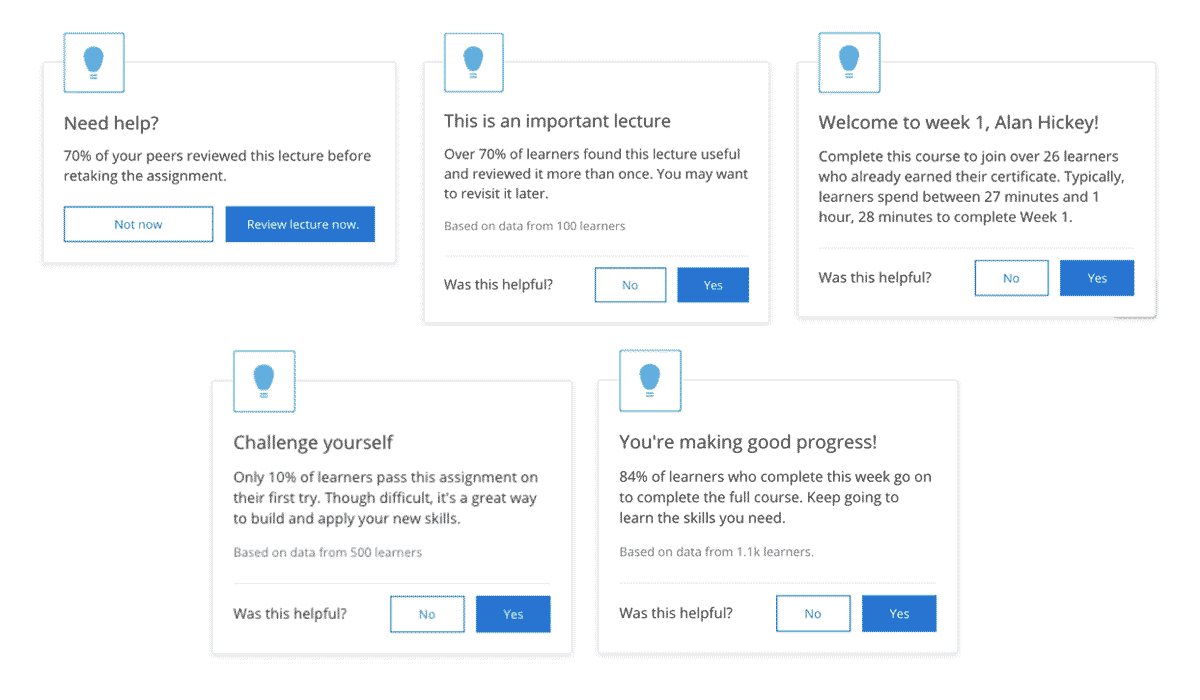
Early this year, we took a look at some of Coursera’s in-course data-driven features, including timely interventions and auto-matching quiz questions with relevant review material.







Beth Fischi
Thanks – a very interesting summary!
I could not agree more on the topic of Guided Projects; these need a lot of work to come up to Coursera’s university course standards. I took one with a poorly coded test that forced students to answer incorrectly in order to pass. I alerted the instructor, but he never responded. I noticed another person posted about the same issue. The course seemed hastily put together.
Otherwise, I have found much of the standard learning on Coursera to be well done and well received.